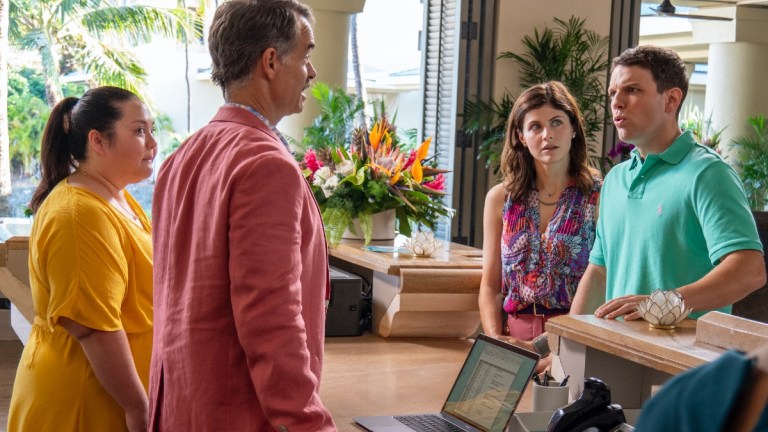The White Lotus Is A Scathing Indictment Of Our Pandemic Behavior
Through six episodes, HBO Max dark comedy The White Lotus perfectly captures the hell of the service industry in the time of COVID.

This article contains spoilers for The White Lotus.
There’s a moment in the first episode of The White Lotus in which a character heads up to the front desk at the eponymous Hawaiian resort and asks the manager for some activity recommendations. Can he jet ski? Nope, a hurricane came through a few days ago and the water is still too dangerous. Can he water ski? Nope. See aforementioned hurricane. The guest gets visibly peeved, but due to the unflagging hospitality of the harried manager, he shakes it off and keeps searching for something to do.
This was – and, in many cases, still is – our COVID reality. Many Americans were outright annoyed at Mother Nature for being so inconsiderate as to derail all our lives. How very dare she? But, since we couldn’t take it out on Mother Nature herself, the service people who had to wrangle our disappointments got caught in the crossfire, often with deadly results.
Even though it’s not explicitly stated, The White Lotus clearly takes place during COVID times. Passing mentions are made to updated cleaning protocols and Zoom meetings, but anyone who has lived through the pandemic (aka: everyone) gets it. Yet, instead of handling the situation with grace and understanding, the guests are all abhorrent to the staff. While the series is making many statements on white privilege, entitlement, and even colonialism, it also serves as a referendum on how very terribly service workers have been treated throughout the pandemic.
Throughout the series, we meet several workers at the White Lotus, and none of them enjoy what might be considered a happy ending. By the time the final credits roll, Kai (Kekoa Kekumano) has been arrested, Dillon (Lukas Gage) has been sexually exploited by his boss, and Belinda (Natasha Rothwell) has lost all faith in humanity. Oh, and the resort’s esteemed manager Armond (Murray Bartlett)? He ded.
Given the high death rates among hospitality workers in the pandemic, it comes as no surprise to find out that the dead body introduced in the first few frames of the series belongs to a resort employee. Some might think that Armond’s trajectory during the week chronicled in The White Lotus is comical, but, as someone who worked as a waitress for over a decade, I feel it’s a fair depiction of a man pushed to the brink. While the other workers at the resort shoulder some of the burden as emissaries of the service industry, Armond’s tragic death ultimately paints the series as his story.
From the moment we meet Armond, he’s wound tighter than a Pepto-colored jack-in-the-box. He’s ready to spring at any second, each interaction with a demanding guest bringing him one notch closer to snapping. And snap he does. Armond is very far from being a saint, but the relentless abuse he endures from the customers, particularly from mommy money bro Shane Patton (Jake Lacy), is cruel and horrifying.
Mike White wrote and directed all six episodes of The White Lotus, and he’s no stranger to wealth and class disparities and the plight of the working class. While he’s written crowd pleasers such as School of Rock, he’s also often been the driving force behind biting stories such as HBO’s critically beloved series Enlightened and the Salma Hayek starrer Beatriz At Dinner that underscore the gaping divide between the haves and have-nots. And White’s vision finally seems to have collided with reality, as The White Lotus has hit such a topical nerve that it’s already been renewed for a second season at HBO Max.
White was approached by HBO in August of 2020 to helm the series, and the show filmed in a COVID bubble at the Four Seasons Resort in Maui from October until mid-December. The resort was closed at the start of the shoot, but as things began to wrap up, guests began arriving again, treating the cast to a first hand account of the very bad behaviors they were depicting on camera. Fred Hechinger, who plays technology-obsessed teen Quinn Mossbacher, was recently quoted in W Magazine as saying, “Every single day, I would see a group of people who were the characters”.
The emotional, and sometimes physical, abuse of workers in the service industry is sadly nothing new, but the pandemic certainly seemed to bring out the worst in people. Just check out popular subreddits r/talesfromthefrontdesk or r/talesfromyourserver. Shortly after COVID hit, those who were still working in hotels and restaurants shifted from writing funny rants about their difficult customers to posting desperate cries for help and understanding. In fact, it’s easy to imagine an r/AITA post from Armond: “This guest at the hotel I manage tormented me all week and tried to get me fired because he got a slightly smaller suite than he originally booked, so I shit in his suitcase. But then he shivved me in the heart and killed me. AITA?”
Or, if you’re not into Reddit, perhaps you’ll recall the Instacart controversy in which customers were plying shoppers with giant tips, only to retract their tips after their orders had been completed. The AARP even had to come out with guidelines for tipping “generously” to help older folks understand why extra would be warranted in a global emergency.
Even though bad tippers proliferated and we were inundated with viral videos of workers pleading with customers to just dear God please put on their masks, not everyone engaged in these reprehensible behaviors. However, the collective “we” failed our front line workers at the start of the pandemic, and we continue to waffle on change as the country begins to pick up the pieces. A $15 minimum wage? Well, maybe. Depends on what state you live in. Nationwide policies that give paid time off for sick leave? Nah. Job protection in the face of outright abusive customers? Forget it.
The fact that the circumstances surrounding Armond’s death mirror so many of these institutional failures is what makes it so haunting. Sure, he broke into a guest’s room and did unspeakable things to his belongings. But he didn’t deserve to die.
The rising tension between Shane and Armond grows throughout the series as Armond tries – and fails – to gain power in a series of unsuccessful ways. In an attempt to feel some sort of control over his life, he relapses, escaping into the Fear and Loathing-esque drug bag that was misplaced by two terrifying teen girls.
Armond’s substance use is the kindling that lights a raging fire of repressed hatred towards all the Shanes of the world, and he begins to burn his entire career down. But instead of upper management noticing that his behavior is erratic and out of character, they give him a buzz and tell him they want to talk to him the next day. Realizing he’s about to be fired, Armond truly snaps. He heads to Shane’s room to enact his final act of revenge, and walks right into a death trap.
White expertly pulls the threads of this tense relationship to build to this single scene. As screen time goes, the moment is brief and anticlimactic. As opposed to the rest of the series, scored by rhythmic drum beats and anxiety-ridden strings, there is a chilling silence as Armond turns a corner and finds the business end of Shane’s knife. Shane panics, pulls the knife out, and mumbles a seemingly sincere “sorry” before fleeing from the room. Armond is left to die alone in the bathtub.
Just like Shane, patrons of the hospitality industry didn’t mean to cause the untimely deaths of the workers keeping everything running throughout the COVID pandemic, but that’s exactly what happened. Few people seem to realize that one of the reasons the service industry is understaffed is because many of the very workers who filled those positions have died during the pandemic. Even now, as the service industry scrambles to find employees to fill vacant jobs, and restaurants pare back their hours due to lack of staff, the general public doesn’t really seem to care about factors like wage parity or on-the-job safety for workers, they’re just focused on making the most of their leisure time.
The final sequence of the series illustrates that people consider workers, even managers such as Armond, to be expendable in the face of consumer wants and needs. As the last few minutes of the series unfold, we get a fleeting glimpse of Shane standing outside of the White Lotus, post-manslaughter, while he interacts with police officers and top-ranking staff at the resort. And they dare to shake his hand. Perhaps they even offered up an apology.
It’s a striking visual. The brief tableau even includes a new guy in a Pepto jacket; presumably this is the new Armond. In the context of the series, the loss impacts no one. As all the wealthy guests depart, Armond is something of an afterthought, a cardboard container unceremoniously loaded into the belly of a plane. But by never allowing us to glean any real closure or meaning from Armond’s death, The White Lotus serves up one last trick. Far after the credits roll, a gnawing sense of unfinished business haunts us. If a hotel manager dies in the middle of the night, and a new one is there to replace him in the morning, did it even happen?
All six episodes of The White Lotus are available to stream on HBO Max now.
